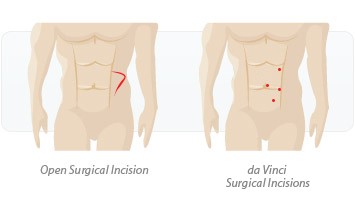Prostate Cancer Surgery
The gold standard treatment option for men age 70 and younger with early-stage, organ-confined cancer is the surgical removal of the prostate using nerve-sparing radical prostatectomy. Prostatectomy also is the most widely used treatment for prostate cancer in the United States.
The primary goal of prostatectomy is the removal of the cancer. A secondary goal is to preserve urinary function and—when applicable—erectile function. Preservation of the nerves necessary for erections can be an extremely important goal for patients. These nerves run alongside the prostate and can be damaged when removing the prostate. A prostatectomy attempts to preserve these nerves so that the patient may be able to return to his prior function.
Surgical Approaches
Approaches to this type of procedure include traditional open surgery, conventional laparoscopic surgery or da Vinci® Prostatectomy, which is a robot-assisted laparoscopic surgery. The surgeon will determine which approach is most appropriate.

With a traditional open procedure, the surgeon uses an 8- to 10-inch incision to access the prostate.
Conventional laparoscopy uses a specialized surgical camera and stiff instruments to access and remove the prostate using a series of small incisions. This approach provides the surgeon with better visualization than an open approach and provides patients with the benefits of a minimally invasive procedure.
Robot-assisted surgery may be the most effective, least invasive treatment option. Through tiny incisions, surgeons can operate with great precision and control, minimizing the pain and risk often associated with large incisions while increasing the likelihood of a fast recovery and excellent clinical outcomes.

